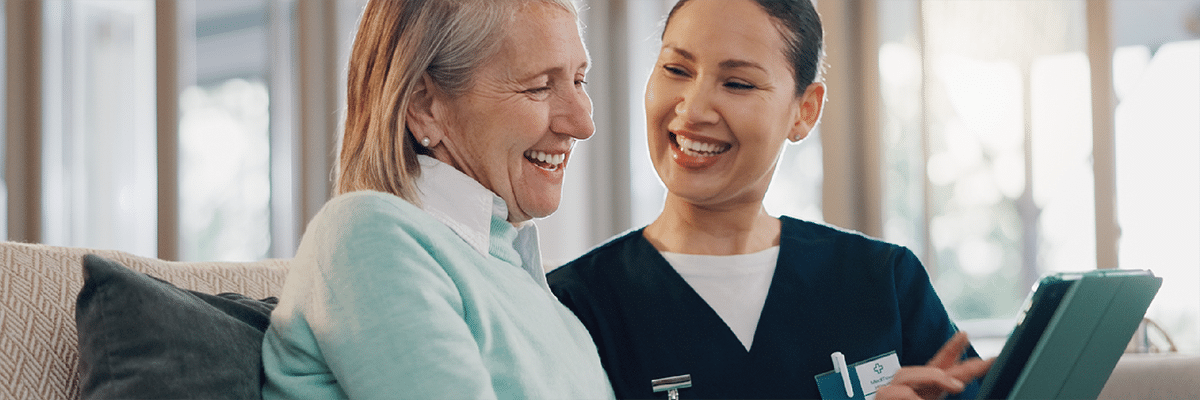As the U.S. baby boomer population ages, many older adults are choosing to remain in their homes rather than move to assisted living or skilled nursing facilities. According to a 2021 AARP survey 77% of adults over the age of 50 want to age in place. This preference is largely driven by a desire for independence and the comfort of familiar surroundings. However, while most older adults hope to age in place, only 49% believe they can afford it — highlighting the need for proactive planning, accessible support and cost-effective solutions that can enable safe, independent living at home.
The Hidden Risks of Aging in Place
While aging at home offers comfort and familiarity, it comes with risks that need to be managed. Common challenges include falls, chronic conditions, medical emergencies, and lack of support for daily needs.
According to the Centers for Disease Control and Prevention (CDC):
- Falls are the leading cause of injury-related deaths among older adults.
- 1 in 4 older adults fall each year, leading to over 3 million emergency department visits.
- Over 50% of older adults and 70% of Medicare beneficiaries have two or more chronic diseases, significantly elevating fall risk.
Research shows that among older adults who fall, about half are unable to get back up on their own. These “long-lie times” can lead to serious complications such as dehydration, pressure injuries, and pneumonia. The fear of falling often leads individuals to limit their daily activities, which can further contribute to physical decline, isolation, and depression.
To mitigate these risks, timely assistance and proactive fall prevention strategies are essential. Implementing home safety modifications and utilizing connected devices such as personal emergency response services (PERS) and remote patient monitoring (RPM) can greatly enhance the safety, health and well-being of older adults.
How PERS Supports Independence and Safety
PERS are designed to provide older adults with a reliable way to call for help—whether for a medical emergency, fall, or simply for reassurance. When equipped with automatic fall detection, these devices can initiate an alert even if the individual is unable to press the button. Connect America’s PERS with automatic fall detection goes a step further by alerting emergency services or caregivers even if the individual is unable to press the button. Beyond emergencies, users can press their button at any time for assistance, to connect with a loved one, to receive reassurance, or to access support services.
Benefits include:
✔ Faster interventions reduce complications from delayed care.
✔ Fewer avoidable hospitalizations help lower healthcare costs.
✔ Increased peace of mind for family caregivers and care teams.
How Remote Patient Monitoring Enables Proactive Care and Personalized Care
Beyond emergency response, solutions like Remote Patient Monitoring (RPM) allow healthcare providers to track patients’ vital signs from home and health trends over time. This steady flow of health data enables providers to detect changes in member’s condition early, allowing for faster, more informed interventions and better chronic disease management. The result: improved outcomes and fewer hospital readmissions.
Benefits include:
✔ Timely identification of potential health issues, enabling quicker intervention
✔ Improved chronic condition management and care plan adherence
✔ Notifications to providers about concerning health changes
The Payer Advantage: Better Outcomes, Lower Costs
For healthcare payer organizations, a connected care strategy that incorporates PERS and RPM can play a critical role in member engagement, retention, and cost containment. These technologies support a shift from reactive care to proactive management, enabling seniors to stay safe and supported at home — while helping payers reduce unnecessary utilization and improve health outcomes.
Key Benefits for Payer Organizations:
✔ Lower Avoidable Care Utilization: Early detection of health risks can help reduce ED visits and hospitalizations.
✔ Improved Member Retention & Satisfaction: Providing safety solutions helps foster trust and enhances the member experience.
✔ Extend Independence: Keeping members safe at home can help delay or prevent the need for institutional care.
Ready to Explore Connected Care Solutions?
Let’s discuss how a proactive care model can help your members age well—safely and independently—at home. Contact us to learn how to implement PERS and RPM solutions that drive better outcomes and lower costs across your member population.

